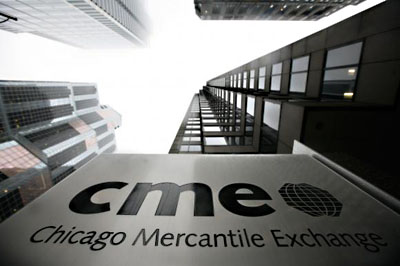 The Wall Street Journal reports today that high-speed traders on the Chicago Mercantile Exchange are exploiting the ability to get confirmation of their own trades a few milliseconds before the rest of the public. Here’s an example of how it works:
The Wall Street Journal reports today that high-speed traders on the Chicago Mercantile Exchange are exploiting the ability to get confirmation of their own trades a few milliseconds before the rest of the public. Here’s an example of how it works:
Firms can use their early looks at CME trading data in several ways. One strategy is to post buy and sell orders a few pennies from where the market is trading and wait until one of the orders is executed. If crude oil is selling for $90 on the CME, a firm might post an order to sell one contract for $90.03 and a buy order for $89.97.
If the sell order suddenly hits, the firm’s computers detect that oil prices have swung higher. Those computers can instantly buy more of the same contract before other traders are even aware of the first move.
I’ve read enough about high-speed trading that I can’t even get too worked up about this. The rich get richer, regular traders pay the price, etc. etc. What really makes this story worthwhile is hearing the high-speed traders try to justify what they do:
Officials with Virtu Financial LLC, a high-speed trading firm in New York, view a slight head start as good for the overall market, according to a person familiar with their thinking. The person said the data helps traders who buy and sell futures contracts throughout the day manage risk and post more quotes that benefit other buyers and sellers. The person said Virtu doesn’t use the information to amplify its profits by anticipating moves elsewhere in the market.
Proponents say eliminating the ability of parties in a trade to get information slightly in advance could lead to less-liquid markets because some firms would be inclined to trade less due to the greater risks.
Yep, you read this right. Giving a few select traders an unfair advantage over everyone else is actually good for everyone else! Why? Because if these lucky traders didn’t have an unfair advantage they wouldn’t make lots of extra sure-thing trades, and these sure-thing trades benefit the entire market because…..
Um, liquidity! It’s the last refuge of the scoundrel and the first refuge of the high-speed trader. They create liquidity, baby, and without that, the entire commodities market, which is famously liquid and always has been, might just seize up and die. Seriously. That’s their story.
I don’t even have the energy to mock this lame nonsense right now. Maybe Felix Salmon will do it in the morning. In the meantime, I’ll just leave you with a further fascinating little nugget. It turns out that the time advantage for high-speed traders is different for different commodities: 2.4 milliseconds for silver futures, 4.1 milliseconds in soybean futures and 1.1 milliseconds for gold futures. Feel free to speculate on why this might be in comments.













